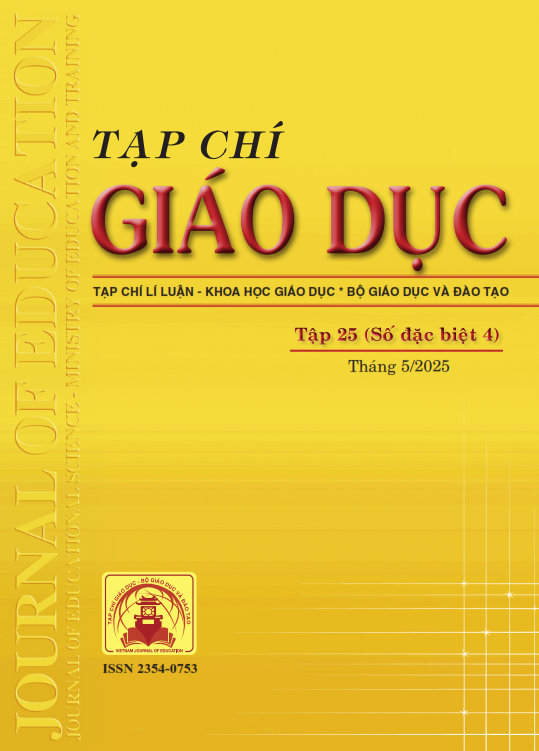Ảnh hưởng của việc tham gia các chuỗi thảo luận trên mạng xã hội đến việc học từ vựng của sinh viên một trường đại học tại Việt Nam
- Từ khóa:
- Social media
- threads
- vocabulary acquisition
Tóm tắt
This study was conducted to investigate the impact of students' participation in social media discussion threads on the vocabulary acquisition of English majors at a university in Vietnam. Using an action research approach, the study focused on evaluating how the duration and frequency of participation in discussion threads affected students’ vocabulary acquisition. Pre-test and post-test, adopted from Nation’s Vocabulary Level Test, were employed to measure students’ vocabulary levels before and after engaging in the social media discussion threads. In addition, classroom observations, student participation journals, and interviews were used to collect qualitative data on students’ perceptions of their experiences with social media discussion threads and the challenges they encountered. The findings indicated that participation in discussion threads on social media had a positive impact on students’ vocabulary acquisition. However, some students still faced difficulties in applying this strategy in practice. This study contributes a perspective on modern English learning environments and sheds further light on the value of using social media as a tool for English language teaching and learning.
Tài liệu tham khảo
Borg, S., & Alsharif, M. (2020). The role of classroom interaction in vocabulary acquisition. Applied Linguistics, 41(3), 1-19.
Donato, R. (1994). Collective scaffolding in second language learning. In V. Murphy & S. E. Carmichael (Eds.), Proceedings of the 18th annual Boston University conference on language development (pp. 3-14). Cascadilla Press.
Dörnyei, Z. (2001). Teaching and researching motivation. Longman.
Dörnyei, Z. (2005). The psychology of the language learner. Routledge.
Hwang, G. J., Wu, P. H., & Chen, C. Y. (2019). The influence of information overload on the effectiveness of social media as a learning tool. Educational Technology & Society, 22(4), 111-121.
Kabilan, M. K., Ahmad, N., & Abidin, M. J. Z. (2010). Facebook: An online environment for learning of English in institutions of higher education? The Internet and Higher Education, 13(4), 179-187.
Kramsch, C. (1993). Context and culture in language teaching. Oxford University Press.
Lamy, M.-N., & Zourou, K. (2013). Social networking for language education. Palgrave Macmillan.
Nagy, W. E., & Herman, P. (1987). Breadth of vocabulary knowledge: The role of context in the learning of words. Journal of Educational Psychology, 79(2), 132-141.
Nation, I. S. P. (2001). Learning vocabulary in another language. Cambridge University Press.
Nation, I. S. P. (2007). Vocabulary learning in another language. Cambridge University Press.
Nation, I. S. P. (2010). Learning vocabulary in another language (2nd ed.). Cambridge University Press.
Oxford, R. L. (1990). Language learning strategies: What every teacher should know. Newbury House Publishers.
Schmidt, R. (1990). The role of consciousness in second language learning. Applied Linguistics, 11(2), 129-158.
Schmitt, N. (2000). Vocabulary in language teaching. Cambridge University Press.
Schmitt, N. (2010). Researching vocabulary: A vocabulary research manual. Palgrave Macmillan.
Service, E. (1992). Phonology, working memory, and foreign language learning. Memory & Cognition, 20(1), 28-38.
Thorne, S. L., & Black, R. W. (2007). Language and identity in the digital age. The International Journal of Computer-Assisted Language Learning and Teaching, 1(4), 34-49.
Tsybina, A. (2016). Social media as a tool for teaching and learning vocabulary. International Journal of Social Media and Interactive Learning Environments, 4(1), 1-12.
Wang, S., & Vásquez, C. (2012). Web 2.0 and second language learning: What does the research tell us?. CALICO Journal, 29(3), 412-430.
Webb, S., & Nation, I. S. P. (2017). How vocabulary is learned. Oxford University Press.
Zhang, D. (2015). Social media and language learning: A case study of Chinese EFL learners. Computers & Education, 88, 202-211.
Đã Xuất bản
Cách trích dẫn
Số
Chuyên mục
Giấy phép

Tác phẩm này được cấp phép theo Ghi nhận tác giả của Creative Commons Giấy phép quốc tế 4.0 .












